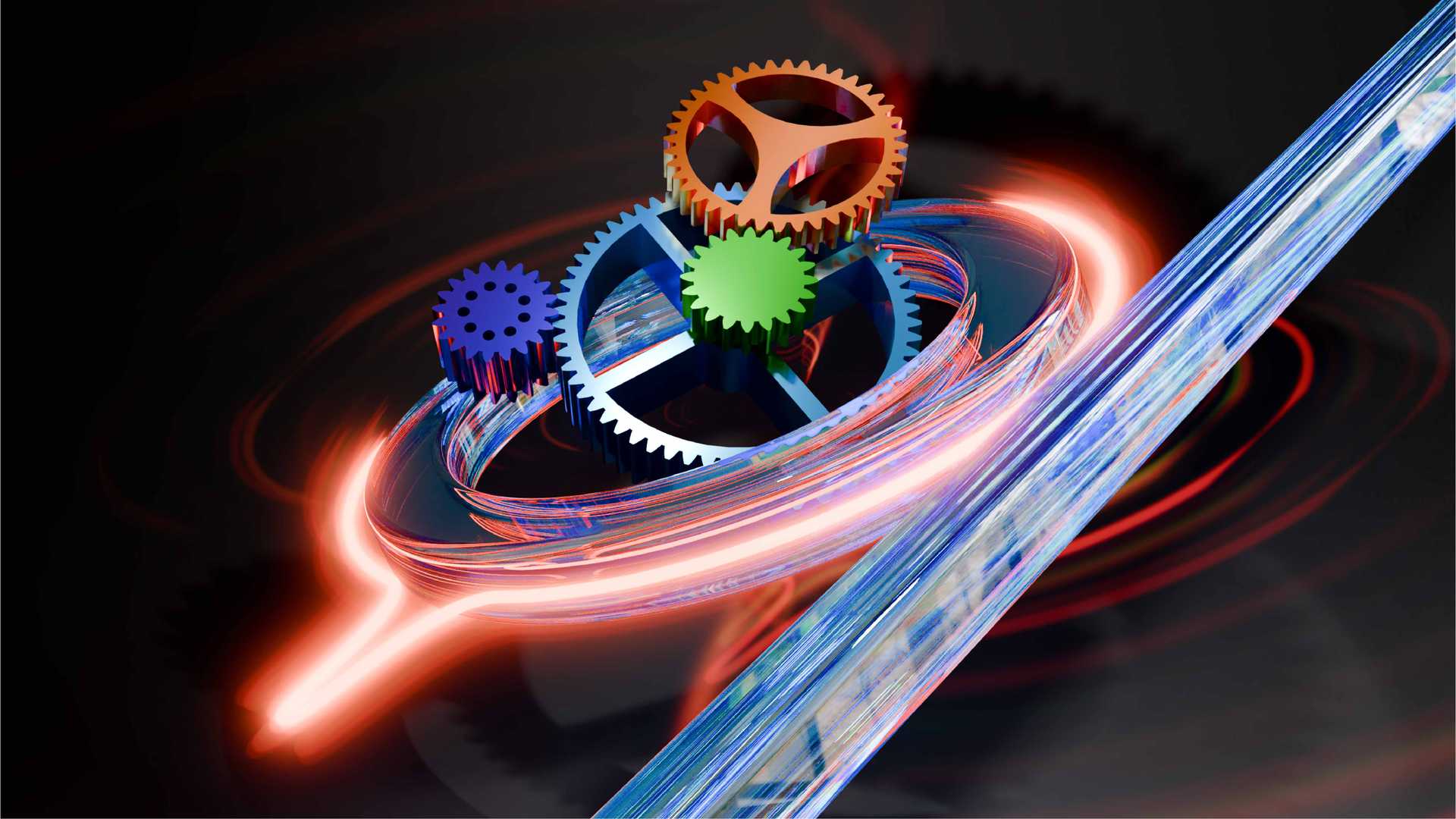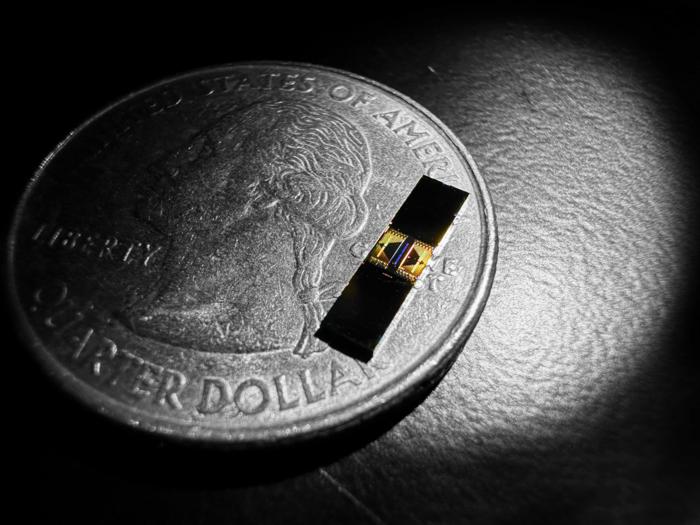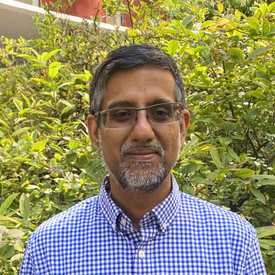Light Synchronization Technique Heralds a Bright New Chapter for Small Atomic Clocks
December 13, 2023
New devices manipulate light for precision measurements and could act as essential clockwork pieces in optical atomic clocks. (Credit: Grégory Moille/UMD)
Humanity’s desire to measure time more and more accurately has been a driving force in technological development, and improved clocks and the innovations behind them have repeatedly delivered unexpected applications and scientific discoveries. For instance, when sailors needed high precision timekeeping to better navigate the open seas, it motivated the development of mechanical clocks. And in turn, more accurate clocks allowed better measurements in astronomy and physics. Now, clocks are inescapable parts of daily life, but the demands of GPS, space navigation and other applications are still motivating scientists to push timekeeping to new extremes.
The best clocks ever made are optical atomic clocks. An atomic clock can be accurate enough that it would have to run for 10 million years to be off by even a second. While atomic clocks might sound like they should be microscopic technology, the best ones actually require a room full of equipment to harness the atoms for timekeeping.

However, researchers are working to improve atomic clocks and the devices they use to read them (often called a clockwork) and to fit them into a smaller package. Future clocks that are very accurate and portable could find uses in a variety of settings, including improving GPS, mapping subterranean features using gravitational variations and detecting if the fundamental constants that describe the universe are changing over time.
The National Institute of Standards and Technology (NIST) has been central in the long history of developing atomic clocks and pushing the limits of metrology—the science and practice of making measurements. And NIST researchers are continuing to improve all pieces of an atomic clock, including the clockwork. As part of the clockwork improvement effort, JQI Fellow Kartik Srinivasan, who is also a NIST fellow, and his colleagues have been exploring how light is altered as it races repeatedly around a minuscule track on a chip. In an article published on December 13, 2023, in the journal Nature, the researchers describe a new way to use the devices to make precision measurements of light. The new technique might eliminate the need for several large, energy-hungry components in next-generation optical atomic clocks and other metrology tasks.
“The ultimate vision is that the type of metrology that exists now in a NIST laboratory might actually be able to exist, even if it's a couple of orders of magnitude worse, outside of the lab,” Srinivasan says.
Atomic clocks are built upon the extreme consistency of atoms. Quantum physics describes how different atoms can gain or lose discrete amounts of energy by absorbing or releasing light. But that transition only happens if the light has exactly the right energy, corresponding to exactly the right frequency—a property describing how quickly light waves vibrate.
For an atomic clock to convert atomic consistency into a precision clock, it must accurately measure the frequency of the light ejected by a group of atoms, and the higher the frequency of light that the atoms produce, the more accurately the atomic clock can operate. Current standardized atomic clocks can divide each second into more than nine billion slices of time by using cesium atoms, which emit light at a microwave frequency. Researchers have already done better using atoms that interact with higher frequencies of light that lie in the optical band that human eyes can see, and a community of scientists, including Srinivasan and his colleagues, are working to make atomic clocks that use optical light smaller and more convenient.
A Tale of Two Clock Designs
The efforts of Srinivasan and his colleagues have not only built upon the existing history of atomic clocks but also on ideas established durring the development of precision mechanical clocks. Atomic clocks were invented at NIST in 1949 and quickly delivered an unprecedented level of accuracy. Then in the 1990s and early 2000s, atomic clocks were revolutionized when researchers, including NIST scientist Jan Hall, developed a precision tool for measuring the frequency of light: the optical frequency comb.
A frequency comb is a light beam that has been spread into many evenly spaced frequencies (receiving its name from the hair comb-like appearance of the frequency distribution). To date, researchers have mostly generated optical frequency combs using a process where light journeys in a loop inside a laser, but the devices Srinivasan and colleagues are studying, called microring resonators, are emerging as an appealing alternative.
The very regular spacing of a frequency comb is useful for measuring frequencies since the frequency difference between an unknown light source and light with a similar enough frequency can be measured when the two overlap. A frequency comb provides a broad array of known teeth to measure frequencies against. However, when a frequency comb is generated, the whole thing tends to jitter slightly, interfering with the measurement.
In the new paper, Kartik and his colleagues point out that the standard method scientists use to combat this jitter resembles a method once used to improve mechanical clocks. The jittering of the frequencies is a similar issue to the natural irregularities of a swinging clock pendulum, which inevitably sticks and gets jostled by nearby commotion. Historically, clockmakers sometimes connected the main pendulum of a clock to a second pendulum so that the idiosyncrasies of one were countered by the pull of the other.
However, just connecting two pendulums with a rod creates more problems than it solves since it increases friction and steals energy from both pendulums. So clever clockmakers took a more active approach and used bulky, power-hungry equipment, including electromagnets, to measure and communicate the swing of a distant second pendulum to the main pendulum.
In current atomic clocks, scientists use a similarly bulky, power-hungry method to stabilize a frequency comb: They connect it to a very stable reference laser using several steps and pieces of equipment. The complicated process includes filtering out a single tooth from the comb, making it interact with a very stable reference laser, measuring the resulting interference and finally feeding the results into electronics that stabilize the frequency comb.
“The size of the system is usually enormous,” says JQI Research Scientist Grégory Moille, who is the first author of the new paper. “You need all these feedback and measurement tools, none of which are usually on-chip, to make it work. So basically, you have a small device but need a lab to make it work.”
When experimenting with multiple light sources inside a microring resonator, Moille, Srinivasan and their colleagues observed a phenomenon that unlocks the ability to directly connect a frequency comb to a stable light source without additional measurements or equipment (and that also fortunately lacks the friction and other issues that plague pendulums). Just feeding the appropriate stable reference laser into the resonator along with the frequency comb makes one of the teeth snap to the reference beam, synchronizing the comb with the reference.
“We were quite surprised with how well this synchronization effect works,” Moille says. “Even with very little light power fed to the resonator, the comb tooth is captured by the laser. The setup is rather simple, and the comb is stabilized, all automatically.”
The team modeled the interactions leading to synchronization and then developed an equation to describe the process and predict its features—like how close the laser frequency needs to be to a comb tooth to synchronize.
Finding a Free Lunch
Even after a frequency comb has been stabilized, researchers still face an additional hurdle before it can be used as a precision frequency measurement tool. While the spacing between teeth is incredibly uniform, the exact value of the first frequency can vary slightly from device to device, so each tick might be slightly offset from its true value—like a ruler with an end that is worn down.
The standard method of identifying the offset involves doubling the frequency of one of the comb teeth (which includes this offset) and comparing it to an unaltered high frequency tooth. In microring resonators, this process can be challenging since each tooth usually only has a small amount of power to work with. But during synchronization, the reference beam contributes extra power. When a comb tooth snaps into alignment with the reference beam, the laser provides a lot of power to that tooth and a smaller amount of power to the higher frequency teeth of the comb.
“Before we would have to use some power-hungry amplifier, or another laser whose frequency difference with respect to the comb would need to be tracked, and so on,” Srinivasan says. “Now it's easier because you have this reference laser that's become your comb tooth. You can directly frequency double this comb tooth. And then this other important bonus comes into play, that the high frequency comb tooth is actually now more powerful as well. So we got a two-for-one in terms of this measurement of the offset frequency. That ends up being a huge advantage.”
A Brighter Future
So far, the team has only tested the new synchronization and alignment techniques with the laser they already had in the lab, and several practical steps remain before the techniques can be implemented into an atomic clock. However, the researchers plan to continue the research and hope to demonstrate a clock using this principle.
In addition to improving clocks, these advancements to frequency comb technology may also contribute to other applications, such as the identification of the atoms and molecules in the atmosphere based on what frequency of light they absorb. The team is also investigating other phenomena that occur in the resonators.
“We know there's beautiful physics, and that synchronization phenomena are ubiquitous in physics and engineering,” Moille says. “We're still trying to understand the extent to which beautiful applications follow. That's kind of how we got into this. There are other groups that have looked at synchronization in these combs just in different contexts. It's just they hadn't looked at this specific thing about synchronization with respect to an external reference. And then it turns out that all the stars line up in terms of this being really well targeted to this specific clock application.”
Story by Bailey Bedford
In addition to Srinivasan and Moille, authors on the publications included JQI postdoctoral researchers Jordan Stone and Usman Javid, JQI graduate students Michal Chojnacky and Rahul Shrestha and University of Maryland, Baltimore County Professor Curtis Menyuk.
Experts
People
![a photo of a man wearing a blue and white checked shirt in front of greenery]()
Kartik Srinivasan
Adjunct Professor, JQI Co-Director
![Profile photo of Gregory Moille]()
Grégory Moille
Associate Research Scientist
Groups
JQI

